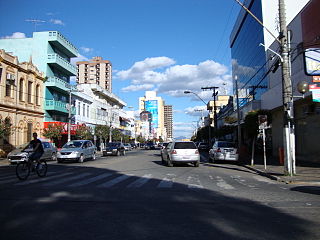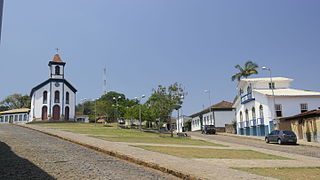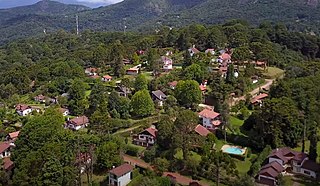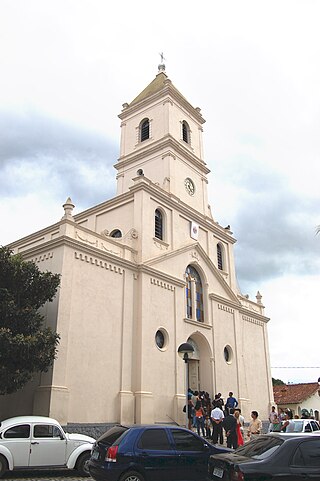
Pouso Alegre is a municipality in southern region of Minas Gerais state, Brazil, with a population of 152,549 in 2020. The area of the municipality is 543 km2. It lies in the valley of the Sapucaí River.

Três Corações is a municipality in the south of Minas Gerais state in Brazil. As of 2020, the city population was estimated at 80,032, making it one of the largest cities in the south of Minas Gerais. The city is geographically located close to the circumcenter of the three largest metropolitan areas in Brazil, thus making it a strategic hub for commerce. Três Corações is internationally famous for being the birthplace of football legend Pelé.

Venceslau Brás Pereira Gomes was a Brazilian politician who served as ninth president of Brazil between 1914 and 1918, during the First Brazilian Republic. Brás was born in Brasópolis, Minas Gerais State. He became governor of that state in 1909, and in 1910 he was elected vice-president under Hermes Rodrigues da Fonseca. As the sixth vice president of Brazil, he also served as the President of the Senate. He was elected president in 1914 and served until 1918. His government declared war on the Central Powers in October 1917 during World War I. He was the longest-lived Brazilian president, reaching 98 years of age.

Varginha is a municipality in southwest Minas Gerais state, Brazil. Varginha stands out as one of the major centers of commerce and coffee production in Brazil and the world. The city is a center for export of coffee draining most of the production of the south of Minas Gerais, making the grain trade with several countries. The city is equidistant from the three largest metropolitan areas in Brazil. The city is close to Rodovia Fernão Dias. The city is served by Maj. Brig. Trompowsky Airport.

Passa-Quatro is a municipality in the state of Minas Gerais in Brazil. The population is 16,393 in an area of 277.22 km2. It is part of the microregion of São Lourenço.

São João del-Rei is a Brazilian municipality in the state of Minas Gerais. Founded in 1713 in homage to king John V of Portugal, the city is famed for its historic Portuguese colonial architecture. The current population is estimated at 90,225 inhabitants.

Santa Bárbara is a Brazilian municipality founded in 1704 and located in the state of Minas Gerais. It is a historic town on the Gold Circuit of Minas Gerais, located ninety-eight kilometres from Belo Horizonte, in the centre of the Estrada Real. The bucolic landscape, with its churches, roofs and backyards at the foot of the imposing Serra do Caraça makes Santa Bárbara one of the most beautiful towns in Minas Gerais. Despite the current increase in economic development, it is a peaceful and welcoming town with simple and hospitable people who preserve their traditions and live an active cultural life. The 6th President of Brazil, Afonso Pena was born in Santa Bárbara.

Paraisópolis is a city in Minas Gerais, Brazil, with a population (2020) of 21,221.

Camanducaia is the southernmost municipality in Minas Gerais, Brazil. Inhabited by 21,801 in 2020.

Pedro Leopoldo is a Brazilian municipality in the state of Minas Gerais. The city is located in the Greater Belo Horizonte region. According to the most recent census of the Brazilian Institute of Geography and Statistics, the population of the city was 62,580 in 2022. The city is birthplace to prominent medium Chico Xavier and 1970 World Champion and Cruzeiro footballer Dirceu Lopes.
Itatiaiuçu is a municipality in the state of Minas Gerais in the Southeast region of Brazil.

Extrema is a municipality in the state of Minas Gerais in the Southeast region of Brazil.

Gonçalves, Minas Gerais is a municipality in the state of Minas Gerais in the Southeast region of Brazil.

Sapucaí-Mirim is a municipality in the state of Minas Gerais in the Southeast region of Brazil.
Toledo, Minas Gerais is a municipality in the state of Minas Gerais in the Southeast region of Brazil.
The Mineiro Republican Party was a Brazilian political party founded on 4 June 1888 and active until its extinction on 2 December 1937 by Decree No. 37 – issued by Getúlio Vargas during the Estado Novo – which abolished all political parties in Brazil. It was one of Brazil's two most powerful parties during the First Brazilian Republic along with the Paulista Republican Party.

The Sapucaí-Mirim River is a river that flows through the Brazilian states of São Paulo and Minas Gerais. Its source lies within the Mantiqueira Mountains and it discharges into the Sapucaí River.

Events in the year 1913 in Brazil.

Events in the year 1914 in Brazil.

The Fernão Dias Environmental Protection Area is an Environmental protection area in the state of Minas Gerais, Brazil.




















